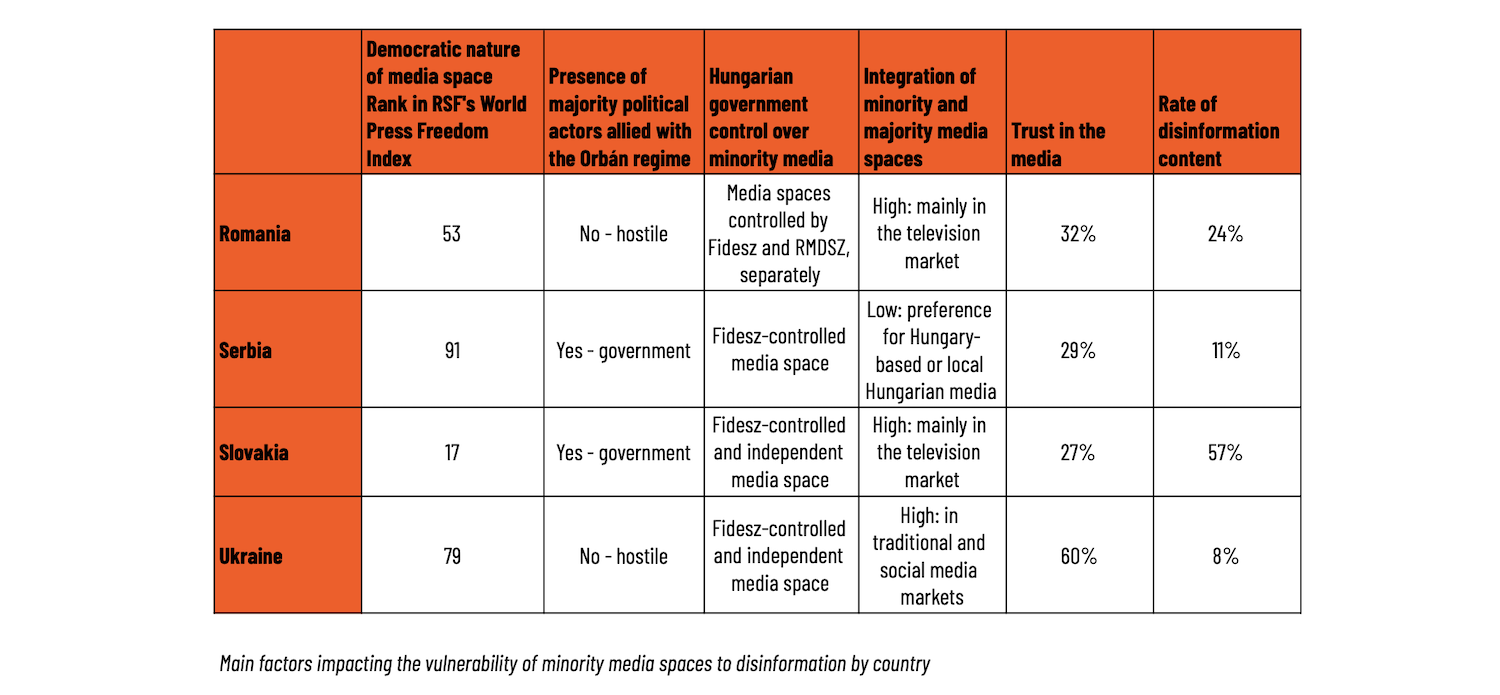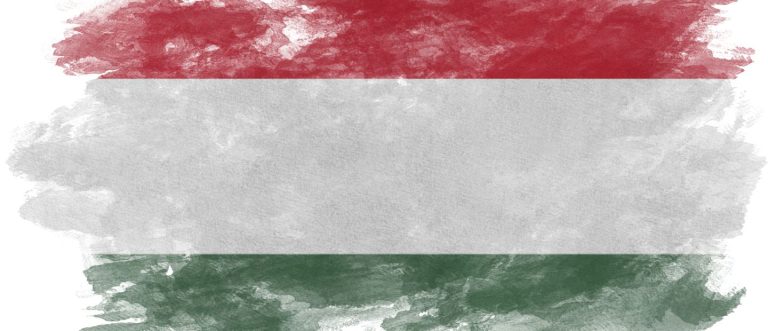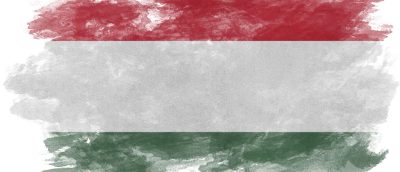(Political Capital) 2023-12-15
(Political Capital) 2023-12-15
The Orbán regime has persistently pursued control over Hungarian minority communities and media in neighboring countries through various measures, primarily financial support, extensively investigated by journalists since 2010. Nevertheless, its disinformation influence has remained undisclosed so far.
Political Capital’s recent analysis of Hungarian-language local media in Slovakia, Ukraine, Romania, and Serbia has revealed how the legitimate representation of Hungarian minority interests has turned into the exploitation of these communities for party interests by exporting “illiberal” values and pro-Russian narratives running counter to the long-term interests of Hungarian minority communities, the national interests of neighboring countries, and the security of the Euro-Atlantic Community.
Hungary’s “illiberal” hybrid regime adopted an expansionist foreign policy to legitimize itself and its oligarchy. It aligned with Eastern autocrats like Alexander Vucic, shielding itself from Western democratic criticism, ensuring its political establishment’s survival in the long term. The Hungarian foreign policy pivot has led to a “multivector” or “bridge” role, attempting to balance commitments to Western alliances with the anti-democratic and corruption-ridden economic and political priorities of Eastern “partners,” primarily Russia and China.
Following Russia’s aggression against Ukraine, Hungary’s ambiguous foreign policy became unsustainable, straining ties with Western and regional allies, notably the Visegrád Four group, and especially Poland. Despite allies viewing Russia’s attack as a major security risk for NATO and Central and Eastern Europe, Prime Minister Viktor Orbán and his media empire continued to criticize Ukraine’s (mis)handling of Hungarians living in Transcarpathia and military aid to Kyiv, while echoing Kremlin narratives about NATO aggression and Russia’s legitimate interests.
Methodology: Our research analyzed the presence of Hungarian government-disseminated disinformation narratives in Hungarian-speaking minority media in Slovakia, Ukraine, Romania, and Serbia from January to July 2023, using qualitative content analysis and quantitative tools. First, we selected influential media and social media platforms based on desktop research, local partners’ input, and their outreach or follower data. Secondly, we monitored and identified four key disinformation narratives in the media selected to extract relevant online articles and Facebook posts using SentiOne and CrowdTangle for the period under investigation. After identifying and categorizing these narratives, we analyzed their content and the network of actors involved in their dissemination.
The colonization of media spaces
Our investigation into Hungarian minority media and politicians in Slovakia, Ukraine, Romania, and Serbia uncovered how the Orbán regime established media monopoly in neighboring countries. The Hungarian government has basically funneled vast funds into political, economic, and religious-cultural initiatives over 12 years, serving both legitimate interests and the creation of a client network parroting Hungarian propaganda. Central to this operation is the Bethlen Gábor Foundation, which in 2020 alone distributed record grants totaling €657.89 million (HUF 250 billion) to minority organizations outside of Hungary.
The pro-Fidesz media network abroad, thus, relies on key local actors in each country. The Hungarian National Council (MNT), under the Alliance of Vojvodina Hungarians (VMSZ), proved to be the decisive organization in Serbia that is affiliated with, for example, the leading RTV media group. RTV received €9 million (HUF 3.5 billion) between 2011 and 2021 from the Hungarian government. In Ukraine, the Cultural Alliance of Hungarians in Transcarpathia (KMKSZ) owns major media outlets disseminating the Orbán regime’s narratives. In Romania, the Democratic Alliance of Hungarians in Romania (RMDSZ) and the Transylvanian Media Association (EME) oversee media favoring the Hungarian government, with EME, which received €4.5 million (HUF 1.45 billion) in 2017, now dominating 80 to 90% of the Romanian minority media.
Slovakia proved to be the most complex case in this respect since it has both a vibrant independent and dependent ethnic minority media landscape. Nevertheless, pro-Fidesz media is run by the Alliance for Common Goals (original budget of €1.5 million), the Association of Hungarian Television Professionals (original budget of €1 million), and the Pro Media Foundation (original budget of €4 million) backed by significant resources of the Bethlen Gábor Foundation.
Two narratives to rule them all
Among the four disinformation narratives we analyzed – concerning the Russian-Ukrainian war, sanctions against Russia, illegal immigration, and gender – the first two were predominant with a 52% ratio in our sample, compared to 48% featuring the other two narratives.
Minority media controlled by local allies echoed the Hungarian government’s “peace” narrative, blaming Hungarian opposition and the West for “warmongering” and escalating the crisis by not supporting an immediate ceasefire and supplying weapons to Ukraine. This narrative portrays the Kremlin as protecting legitimate political or minorities’ interests as well as defending a traditionalist, Christian Europe. Country-specific narratives added minor variations, like Western responsibility for the war in Serbian discourse or the Hungarian government’s role in protecting Transcarpathian Hungarians against the Ukrainian government. Notably, these disinformation narratives often omit Russia’s role in the Ukraine war as well as responsibility for future peace talks.
Although culturally framed narratives on gender or illegal immigration did not prove to be potent in all countries (i.e., gender in Ukraine and Serbia, migration in Ukraine), they were still linked to the war in some conspiracy theories elsewhere. For example, a piece on the Hungarian government-funded news site in Slovakia, Felvidék.ma, accused the European Commission of conducting “sensitivity training” advocating “not only (…) for gender reassignment, for a radical change in the traditional family model, but also for the consequences of the poverty into which the people of Europe have been plunged by its irresponsible sanctions policy.” Another piece in the same outlet alleged that the EU is using the war in Ukraine to eradicate minorities to “breed” a “new globalized nation.”
Vulnerability and national security of minorities abroad
To assess the vulnerability of Hungarian minority communities to disinformation, we compared them along six dimensions: their countries’s ranking in the 2023 World Press Freedom Index; PM Orbán’s political allies in the majority political sphere in their countries; the extent of the Hungarian government’s control over the minority media space; the integration of minority and majority media spaces, trust in media; and the ratio of disinformation narratives for each country in our sample.

We concluded that the most vulnerable are those Hungarian minority communities that are dominated by Orbán-influenced minority media outlets and hardly consume majority-language media. Their vulnerability increases in countries with Orbán’s ideological allies in power alongside a mainstream media landscape that is less democratic, more prone to disinformation, and marred by widespread media distrust. Consequently, the Serbian diaspora emerged as highly susceptible, receiving disinformation from both the Hungarian and Serbian governments. Conversely, Romania’s media environment is ‘healthier’ due to press freedom, somewhat antagonistic Hungarian-Romanian governmental relationship, and ethnic Hungarians (somewhat) consuming more balanced Romanian majority-language media, too. Ukraine, despite anti-disinformation efforts, can be considered less resilient due to wartime media censorship.
The impact of Hungarian regime propaganda and associated disinformation abroad is three-fold. First, exerting control over Hungarian minority public spheres, creating dependency and consciously polarizing these communities along partisan lines weaken these communities’ cohesion and self-defense capabilities against foreign hostile political or information influences. Second, the spread of centralized disinformation increases susceptibility to misinformation and distrust in independent media among both majority and minority populations. Third, anti-EU, pro-Kremlin and anti-Ukrainian narratives, as well as those increasing social polarization around the war and minorities’ alleged role in territorial disputes, strengthen pro-Kremlin actors and erode trust in NATO and Euro-Atlantic structures.
This situation presents a risk of regional destabilization, as the Hungarian diaspora could become a target of Russian “active measures.” A clear attempt for this occurred in 2018, when Polish extremists funded by Russian intelligence services firebombed the Hungarian Cultural Center in Uzhhorod, Ukraine. Additionally, current Kremlin media disseminates conspiracy theories about Poland, Hungary, and Romania allegedly conspiring, with NATO’s backing, to “divide” Ukraine and reclaim lands inhabited by ethnic minorities. Therefore, it is imperative to strengthen independent media platforms and enhance international cooperation and vigilance to monitor and counteract destabilizing propaganda efforts, particularly in regions with vulnerable ethnic minorities.







